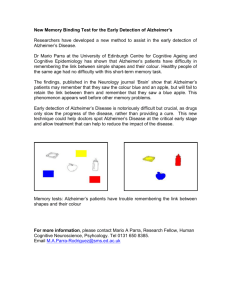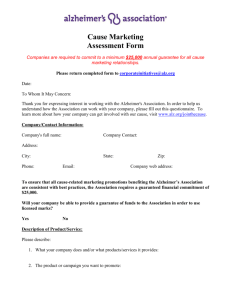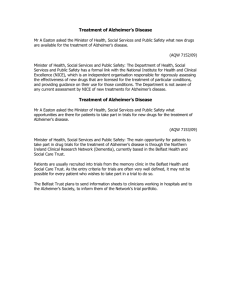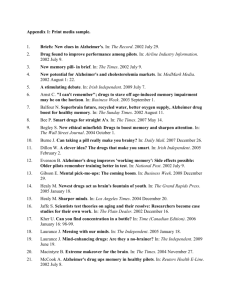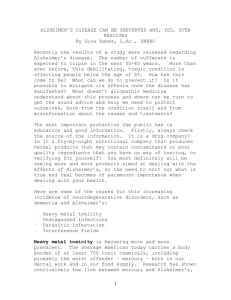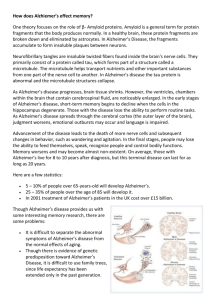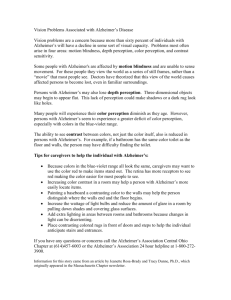UC to raise $1 billion for students UC Davis leads attack on global
advertisement
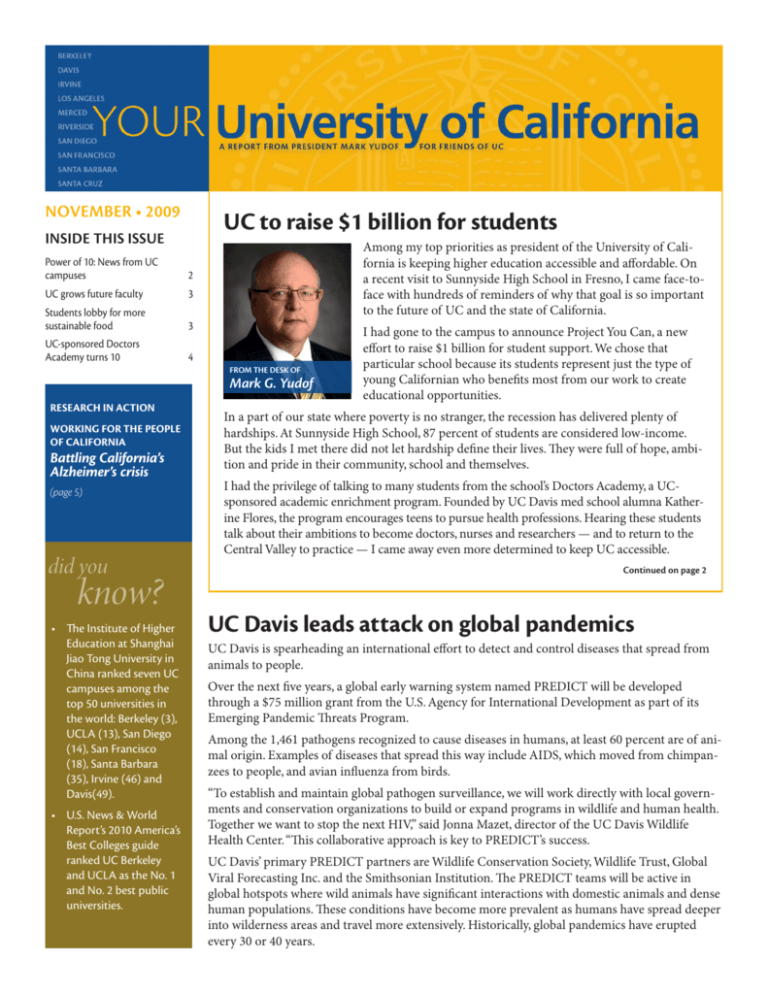
NOVEMBER • 2009 UC to raise $1 billion for students INSIDE THIS ISSUE Power of 10: News from UC campuses 2 UC grows future faculty 3 Students lobby for more sustainable food 3 UC-sponsored Doctors Academy turns 10 4 Among my top priorities as president of the University of California is keeping higher education accessible and affordable. On a recent visit to Sunnyside High School in Fresno, I came face-toface with hundreds of reminders of why that goal is so important to the future of UC and the state of California. FROM THE DESK OF Mark G. Yudof RESEARCH IN ACTION WORKING FOR THE PEOPLE OF CALIFORNIA Battling California’s Alzheimer’s crisis (page 5) did you know? • The Institute of Higher Education at Shanghai Jiao Tong University in China ranked seven UC campuses among the top 50 universities in the world: Berkeley (3), UCLA (13), San Diego (14), San Francisco (18), Santa Barbara (35), Irvine (46) and Davis(49). • U.S. News & World Report’s 2010 America’s Best Colleges guide ranked UC Berkeley and UCLA as the No. 1 and No. 2 best public universities. I had gone to the campus to announce Project You Can, a new effort to raise $1 billion for student support. We chose that particular school because its students represent just the type of young Californian who benefits most from our work to create educational opportunities. In a part of our state where poverty is no stranger, the recession has delivered plenty of hardships. At Sunnyside High School, 87 percent of students are considered low-income. But the kids I met there did not let hardship define their lives. They were full of hope, ambition and pride in their community, school and themselves. I had the privilege of talking to many students from the school’s Doctors Academy, a UCsponsored academic enrichment program. Founded by UC Davis med school alumna Katherine Flores, the program encourages teens to pursue health professions. Hearing these students talk about their ambitions to become doctors, nurses and researchers — and to return to the Central Valley to practice — I came away even more determined to keep UC accessible. Continued on page 2 UC Davis leads attack on global pandemics UC Davis is spearheading an international effort to detect and control diseases that spread from animals to people. Over the next five years, a global early warning system named PREDICT will be developed through a $75 million grant from the U.S. Agency for International Development as part of its Emerging Pandemic Threats Program. Among the 1,461 pathogens recognized to cause diseases in humans, at least 60 percent are of animal origin. Examples of diseases that spread this way include AIDS, which moved from chimpanzees to people, and avian influenza from birds. “To establish and maintain global pathogen surveillance, we will work directly with local governments and conservation organizations to build or expand programs in wildlife and human health. Together we want to stop the next HIV,” said Jonna Mazet, director of the UC Davis Wildlife Health Center. “This collaborative approach is key to PREDICT’s success. UC Davis’ primary PREDICT partners are Wildlife Conservation Society, Wildlife Trust, Global Viral Forecasting Inc. and the Smithsonian Institution. The PREDICT teams will be active in global hotspots where wild animals have significant interactions with domestic animals and dense human populations. These conditions have become more prevalent as humans have spread deeper into wilderness areas and travel more extensively. Historically, global pandemics have erupted every 30 or 40 years. POWER OF 10 SYSTEMWIDE NEWS Yudof continued from page 1 News from UC campuses UC Berkeley is creating a plan to turn a former gold mine in South Dakota into the world’s deepest laboratory with a $29 million National Science Foundation grant. UC Davis will lead a federally funded Horticulture Collaborative Research Support Program to fight hunger and malnutrition in rural communities in sub-Saharan Africa, southern Asia and Latin America. UC Irvine researchers have discovered what causes a cancer-causing toxin to form on moldy nuts and grains. Their discovery would help prevent some cancers. This month UC Regents must vote on fee increases for the rest of 2009-10 and for 2010-11 that would total roughly 32 percent. Believe me, none of us at UC wants to take this action. We know that for many students, fee increases will seem an insurmountable impediment. That is why our campuses are stepping up their student support efforts with a $1 billion systemwide private fundraising drive. Project You Can will seek to double the money the 10 campuses collectively raised over the last five years for undergraduate, graduate and professional school students. In addition, I’m asking Regents to raise the income ceiling on the Blue and Gold Opportunity Plan to $70,000 to cover more lower-income families. Currently, the plan pays the systemwide fees for California students with household incomes of $60,000 and below who qualify for financial aid. UC will continue to set aside a third of undergraduate fee increases and half of graduate fee increases for financial aid. Increases in UC, state and federal grants and in federal tax credits are expected to cover the 2009-10 fee increases for three-quarters of undergraduates with household incomes below $180,000. UCLA’s Center for Health Policy Research has concluded that if any of three national health care reform plans under discussion are approved, about 4 million uninsured Californians would be covered. This month, UC Regents will also vote on a budget that seeks to stabilize the university’s finances with a request for increased state funding of $900 million. The budget request is part of a vigorous advocacy campaign to ask the state to restore all of the money it took away last year, to begin contributing to the UC Retirement Plan and to renew California’s commitment to public higher education. UC Merced’s economic impact in California has reached nearly $1 billion since July 2000 when operations began. The campus has generated nearly $456 million in payroll, construction jobs and purchases in the San Joaquin Valley. With the state facing projected budget deficits of $7 billion or more, I know everyone must share the pain of California’s economic crisis, and UC is doing its share of sacrificing. But we can’t continue to slice away at academic programs, staffing levels and faculty and research support without jeopardizing the university’s quality and its ability to serve California. UC Riverside is giving 40 middle school math and science teachers an opportunity to learn teaching methods aimed at reducing the achievement gap among racial and ethnic groups. State per-student support has shrunk by half in the last 20 years. That downward trend creates financial obstacles to education that Sunnyside High students and thousands more like them throughout the state should not have to face. It’s time to reverse this trend. UC San Diego researchers have found an enzyme that slows the progression of Lou Gehrig’s disease in mice. They hope to test the treatment on humans within five years. UC San Francisco and San Francisco VA Medical Center researchers collaborated on a study of surgery survival rates among veterans with post-traumatic stress syndrome. PTSD patients had a lower one-year survival rate than patients without PTSD. UC Santa Barbara Chancellor Henry Yang has been elected chair of the Association of American Universities, a group of 60 U.S. and two Canadian elite research universities. UC Santa Cruz researchers will help lead an Antarctic expedition to drill a half-mile through ice sheets to study subglacial lakes, among the last unexplored aquatic environments on Earth. For more campus news, visit www.universityofcalifornia.edu/youruniversity Many thousands of students and families across the state will be counting on these fundraising and state advocacy efforts to succeed. Much is at stake. During these challenging times, UC needs help from all its supporters and friends. Whether it’s contacting legislators, joining an advocacy effort or contributing to a student scholarship, you can make a difference by standing up for higher education and the California students who deserve one. Contact me at president@ucop.edu. Although I will read all your e-mails, I am not able to personally respond to every one. I encourage you to follow me on Facebook and Twitter, where you can share your ideas and find updates on our student support efforts. Click for it! Visit www.universityofcalifornia.edu/youruniversity for these Web-only features: Project You Can – Invest in the future of California. UC Health – Follow UC health news. Provocative thinking – Check out the Berkeley Blog for expert opinions on everything. Track UC budget crisis – Follow news of how state funding cutbacks impact UC. 2 SYSTEMWIDE NEWS UC grows future faculty The UC President’s Postdoctoral Fellowship Program offers new doctoral degree recipients get a jump-start on their academic careers while helping campuses diversify their faculty. “I probably wouldn’t be a professor if it wasn’t for the fellowship,” said Wayne Yang, an assistant professor in the ethnic studies program at UC San Diego since 2006. Yang graduated from UC Berkeley in 2004 with a doctorate in social and cultural studies in education and took part in the postdoctoral program. Founded in 1984, the fellowship is one of the pioneering programs designed to foster diversity in academia. The program encourages doctorate recipients whose teaching, research and service contribute to diversity to pursue academic careers. UC Regents made achieving diversity among students, staff and faculty a policy goal in 2007. UC’s ladder-rank faculty members are more diverse than the faculty at the public and private universities who make up the elite Association of American Universities, according to UC’s diversity accountability report. Yet white men still account for the majority of faculty at all UC campuses. The fellowship program seeks to change those statistics. “These are scholars who bring critical skills on how to be a more diverse and inclusive University of California,” said Sheila O’Rourke, program director. “They understand the needs of minority students. Many of them have worked in minority or with minority communities, so they are fluent in those issues.” UC fellows, who can be of any race or gender, receive research suppport, professional development and faculty mentoring. The program offers 15 to 20 fellowships a year. From 2001 through 2006, more than 75 percent of fellows received Wayne Yang spent 15 years as a high school teacher before joining the faculty at UC San Diego. tenure-track positions, and UC campuses hired more than 40 percent. Since 2003, the UC Office of the President has provided a partial salary supplement for five years to UC campuses that appoint current or former fellows to ladder-rank faculty positions. Overall, 77 former fellows have been hired by a UC campus since 2003. UC Davis and UCLA have hired the most fellowship participants with 17 each. O’Rourke said enhancing faculty diversity may become more difficult as budget cuts curtail hiring, but programs such as this are “more important than ever if we’re going to be relevant to the state of California.” “If we’re going to have any credibility with the state and serve the needs of the people, we have to address diversity,” she said. Students lobby for more sustainable food Responding to requests from thousands of students, UC has expanded its sustainability policy to deliver more organic and locally grown food to campus and medical center dining. UC Regents received 10,000 postcards from students asking for more sustainable food options. As a result, university policy was updated to require that 20 percent of all food purchased be designated sustainable by 2020. “UC has taken a bold step toward protecting our environment and nourishing all of the people in our food system — not only the students and staff who eat in our dining halls, but also the many people who grow, process and serve our food,” said Kelsey Meagher, a UC Irvine senior who was one of 40 students, food service workers and dining hall staff members who worked on the policy. Last year, Meagher and Hai Vo, who has since graduated, conducted a sustainability assessment of UC Irvine food purchas- ing. Both are leaders in the Real Food Challenge, a nationwide student network advocating for colleges and universities to buy more sustainable food. More than 300 universities have chapters. The definition of sustainable outlined in the UC policy includes products such as fair trade-certified coffee, USDA certified organic products, cage-free, grass-fed or pasture-raised food and products purchased from cooperative businesses or employee profit-sharing ones. Locally grown food must come from within 500 miles of the UC location. By December 2010, at least one dining facility at each UC location must be certified by an outside agency as a green business if financially feasible. Each campus must also provide sustainability educational outreach to students and work with the surrounding community on common sustainability goals. 3 IN THE SPOTLIGHT UC-sponsored Doctors Academy turns 10 preparation, financial aid workshops and parent empowerment workshops. Students are required to take AP courses and participate in community service learning activities and cultural competency/health disparity projects. “We want our kids to believe in themselves,” said Flores, a practicing family physician and graduate of UC Davis medical school. “If you raise the expectations, they can meet them and exceed them.” Despite Fresno’s high dropout rate, all Doctors Academy graduates have attended two- or four-year colleges, with 43 percent going to UC campuses. Some are in medical school and dental school, while others are nurses and many plan to help fill a hometown shortage of health professionals. Dr. Katherine Flores talks about medicine with Doctors Academy students. Raised by her migrant farmworker grandparents, Fresno native Katherine Flores worked in the fields herself as a youth, picking apricots, pears and plums. The first in her family to attend college, she became a doctor and now her hometown community is reaping the fruits of her labor. Flores, a UCSF assistant clinical professor and director of UCSF Fresno’s Latino Center for Medical Education and Research, started the Doctors Academy in 1999 at Sunnyside High School. The innovative, University of California-sponsored program prepares disadvantaged students for college and for health science careers. The Doctors Academy now includes three high schools in Fresno County, a Junior Doctors Academy at three middle schools and the Pre Health Scholars program at Fresno State. Their combined annual enrollment is 430 students – a diverse group with 55 percent of the participants Latino, 17 percent Southeast Asian, 12 percent East Indian, 7 percent African American and 7 percent white. “As a farmworker, you see a lot of social injustice,” Flores said. “What stood out to me were the health inequities. My grandfather was diagnosed with diabetes when I was very young. I remember him developing gangrene in his leg, which required an amputation, and I lived through the culturally incompetent health care process with him. I believe that there should have been a better way for my grandfather to have received care.” The Doctors Academy, a partnership with UCSF Fresno, the Fresno Unified School District, Fresno County Office of Education, Fresno State University, Fresno City College, local hospitals and community health centers lays a foundation for easing those health inequities. It includes summer enrichment programs, tutoring, mentoring, guidance counseling, SAT 4 “I’m just really thankful to the Doctors Academy,” said alumnus Nathan Singh, a second-year medical student at UCSF. “It’s hard to put into words the impact this program is having.” “We want our kids to believe in themselves.” Dr. Katherine Flores The academy pushed Singh to do well in classes, provided support and offered opportunities to volunteer. In a “seminal moment,” Singh changed the dressing on someone shot in the leg. “It really gave me a face-to-face personal experience with medicine that I hadn’t had before,” he said. Singh plans to return to the valley to practice orthopedic surgery or family medicine. And help with the Doctors Academy. “I look at it as a way to give back to a community that has given a lot to me in my 23 years,” Singh said. “I look at it as a way to give back to a community that has given a lot to me in my 23 years.” Nathan Singh, second-year medical student at UCSF Research in Action Working for the people of California Bill and Susan Long sometimes bicker playfully when he can’t recall simple things, like where he left his keys just a minute ago. But their real fight is for time. Bill Long, 70, was diagnosed two years ago with early stages of Alzheimer’s disease, and some days he can’t remember the names of his grandchildren. Still able to work two days a week at Home Depot, Bill keeps a tight grip on the independence he has left, knowing full well that the disease can eventually rob him of all his mental and physical abilities. He admits that his wife may be the tougher of the two. It was her “pit bull mentality,” he said, that cleared health care hurdles to get her husband properly diagnosed after his forgetfulness and changes in behavior were more serious than “just getting old.” She also got him referred last year to the UC Davis Alzheimer’s Disease Research Center “We have a medical system and into a clinical trial of and societal infrastructure a drug which they hope that’s not at all prepared to will slow the disease and deal with this problem.” extend Bill’s good and Joshua Chodosh healthy years. UCLA geriatrician Although tenacious, Susan Long is the worrier. She frets about someday not being able to provide the 24/7 attention that her husband may need, that he will end up in a nursing home and they will lose their entire savings to pay for his care, or that someday her husband of 48 years will not even recognize her. “But I’m hopeful that the drug, or another that will be discovered, will work,” she said. “I want to be with the Bill I know and love for a long, long time more, and in our home.” Pending epidemic The clinicians, researchers and advocates battling Alzheimer’s disease know that the clock is ticking for the Longs and hun- dreds of thousands of others like them. A UC report earlier this year sounded the alarm with projections of a dramatic rise in the number of Alzheimer’s cases in California. A state task force was formed recently to develop a plan on how California can best respond to an impending Alzheimer’s epidemic. “As the baby boomer generation ages and as people live longer, Alzheimer’s disease has become an urgent issue,” said Patrick Fox, co-director of the UCSF Institute for Health and Aging and an author of the report. He noted that among California’s baby boomers age 55 and older, one in eight will develop Alzheimer’s. “The data indicate the economic and human costs of Alzheimer’s disease will be insurmountable for our state if we don’t Key findings from UCSF’s Institute for Health and Aging report for the Alzheimer’s Association • The number of people in California with Alzheimer’s will nearly double from 588,000 today to nearly 1.1 million by 2030. • One-tenth of the all the nation’s Alzheimer’s patients reside in this state. • The number of Caifornia’s Latinos and Asians living with the disease will triple by 2030 and the number of African Americans will double. • The annual cost for caring for Californians with the disease could soar to nearly $100 billion in the next 20 years. • Some 1.1 million Californians today take care of people with Alzheimer’s. Three-fourths of these caregivers are family members. • Alzheimer’s is now the sixth leading cause of death in the state. 5 Research in Action Working for the people of California act now,” said state Senator Elaine Alquist when the state task force was announced in late September. The UCSF report, partly funded by the California Department of Public Health, offered several recommendations, including building a comprehensive health and long-term care service network for Alzheimer’s patients, improving access to care for diverse racial and ethnic groups, developing policies and services to support family caregivers, increasing the number of workers trained in geriatrics, and more funding for research. California ramping up a plan The report also urged the state to speed up a plan for dealing with the burgeoning number of Alzheimer’s cases. “The state has not conducted a thorough review of its policies and practices related to Alzheimer’s since 1987,” said Fox. “Certainly, a lot has changed, and not just the numbers. We know a lot more about the disease than we did 20 years ago.” But Fox acknowledges a much too familiar conundrum – so much need, not enough money. The state, with its budget crisis this year, made severe funding cuts to Alzheimer’s research centers, caregiver resources and adult day health care. “The state forecast shows the perfect storm,” said Joshua Chodosh, a UCLA geriatrician who researches dementia and health services utilization. “We have the anticipated increase in the numbers of cases of Alzheimer’s and dementia and at the same time a drastic state budget situation.” Chodosh was named co-chair of the state’s Alzheimer’s disease plan task force, which will present its findings to the state in early 2011. “We have a medical system and societal infrastructure that’s not at all prepared to deal with this problem,” said Chodosh. “At the same time, we have a chance to be creative in finding solutions and using the limited amount of dollars for some critical needs. California needs to be at the forefront in tackling Alzheimer’s and dementia.” The UCSF study found that California employers lose $1.4 billion in productivity because many employees miss work, reduce their hours or change jobs when a family member is stricken with Alzheimer’s. Research importance “Accelerating state research funding will hasten the day when people will be able to delay the debilitating symptoms of Alzheimer’s,” noted the UCSF report. “A delay of just five years could cut prevalence rates in half.” Throughout the UC system, hundreds of researchers are studying Alzheimer’s disease. Scientists seek what triggers the excess protein production that forms plaques and tangles that jam brain signaling and eat away at the brain. Imaging experts develop tools to detect the disease at its earliest stages, clinical researchers test drugs that may stave off the disease, and social scientists and policy experts study the impact of the disease. “UC people and researchers throughout the state have been invaluable leaders and partners in raising awareness of the disease,” said Debra Cherry, associate executive director of the Alzheimer’s Association in Southern California. Cherry cites the leading work at the Alzheimer’s Disease Research Centers of California, established by the state in 1984 to provide comprehensive care to sufferers of Alzheimer’s and related disorders and to aid in ultimately discovering the cause and cure of the disease. Of the 10 centers in the state, UC directs seven. The UC Davis Alzheimer’s Disease Center serves not only as top referral center for the Alzheimer’s patients, it trains health professionals and advocates for national and statewide changes in health policy and practice that will improve diagnosis and management of the disease. The center was founded with state funds some 25 years ago, but blossomed into a national center, too, attracting key federal funds to conduct more than 30 research projects and clinical trials. For many of its studies, it collaborates with its sister UC centers and other research institutions. Increases projected for blacks, Latinos One of the center’s priorities is reaching out to various ethnic groups, said director Charles DeCarli. One major federally funded study has recruited some 430 white, black and Latino patients with some cognitive impairment to be studied until they die. Researchers may determine unique factors in development of Alzheimer’s in these ethnic and racial groups, particularly African Americans, faced with a projected doubling in the number of cases in 20 years, and Latinos, whose rates will triple. “For many Latinos and in other cultures, caring for an aging parent or grandparent is something you automatically do when the time comes,” said Esther Lara, a clinical social worker and research administrator at the UC Davis center. “Often when they see senility or what may even be Alzheimer’s, they think its part of the process and they never seek outside care for the elder or themselves.” .Lara sees first hand the soaring number of Alzheimer’s cases. She’s saddened that many aren’t getting the proper care because primary care doctors and clinics are not prepared to handle them. She is also seeing an increasing number of people in their early 50s with early stages of dementia or Alzheimer’s. “They are still working, paying a mortgage and supporting their families,” she said. Still, she’s heartened by those who volunteer for the research. They travel far to the center for periodical cognitive and physical tests. “They’re very proud to be part of important research.” Bill Long, the UC Davis Alzheimer’s Center patient and clinical trial participant, gives his time and even his blood for the sake of science. “I’m willing to be a human guinea pig if it helps find a cure for this disease.” Your University is produced 10 times per year by the Integrated Communications department of the University of California Office of the President. For suggestions or comments about this report, contact: Donna Hemmila, editor, 1111 Franklin St. 12th Floor, Oakland, Calif. 94607, 510.987.0793, donna.hemmila@ucop.edu

